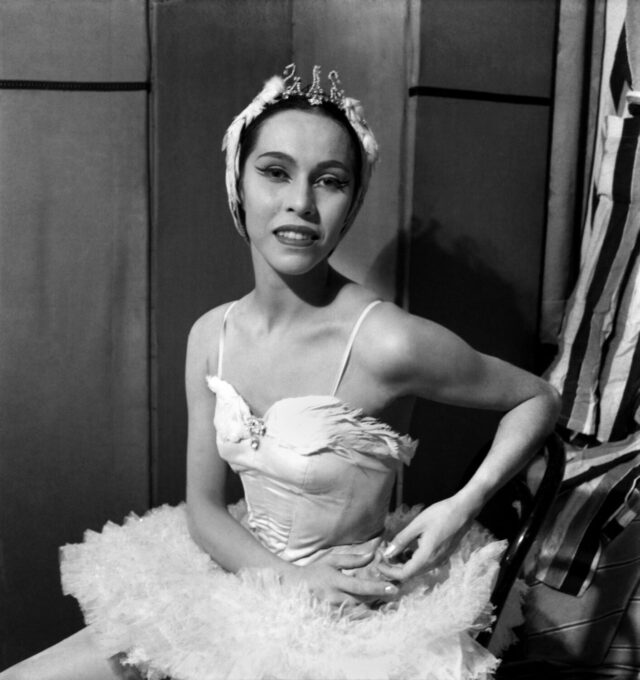
(CNN) — The Osage Ballet overlooks a creek in Pawhuska, Oklahoma, on the Osage Indian reservation.
Before class, students can be found warming up with plies and battements, battering pointe shoes or learning about America’s first prima ballerina, who inspired the school’s founding: Elizabeth Marie Tallchief.
Tallchief, an Osage woman who revolutionized ballet in the 1940s and ‘50s, died in 2013, at 88. The Osage Ballet hopes to continue to inspire a new generation of dancers in her honor.
Randy Tinker Smith, director at the ballet company, said she’s often asked why the tribe opened the non-profit dance school.
“I’ve never had an Osage ask me that question because we understand (Tallchief’s) legacy,” Smith said.
America’s first prima ballerina
Born on Jan. 24, 1925, in Fairfax, Oklahoma, on the Osage reservation, Tallchief began ballet training at three years old. Her family, like many of the Osage nation, lived on quarterly oil royalty checks.
After oil was discovered on Osage land and brought wealth to their community, White settlers murdered dozens of Osage to steal their mineral rights, as depicted in the book, recently made into a movie, Killers of the Flower Moon.
Tallchief’s family used their wealth to move to Beverly Hills when she was eight years old.
At 17, Tallchief began dancing with New York’s Ballet Russe de Monte Carlo where she was advised to change her last time to appear more Russian, as many of the leading ballerinas of her time were. But Tallchief refused and insisted on dancing as Maria Tallchief, keeping her Osage name, according to a biography of the ballerina by the School of American Ballet.
Elise Paschen, Tallchief’s daughter and a poet, told CNN her mother took great pride in her heritage.
“She spent a lot of time in Oklahoma on the Osage reservation,” Paschen said. “She was able to live in both worlds – both the Osage world of her culture of the nation, as well as … becoming this very famous prima ballerina.”
Kate Mattingly, a professor of dance history at Old Dominion University, said Tallchief’s Osage heritage influenced her approach to dance.
“Within indigenous cultures … dancing is a form of knowledge and a form of communication,” Mattingly told CNN.
In the United States dance had long been treated as a separation of mind and body and was more technical. But Tallchief brought emotion and athleticism to ballet and helped popularize the style of dance at a time where it was viewed as foreign because it came from Europe, Mattingly said.
In the 1940s, Tallcheif began working with famed ballet choreographer George Balanchine, and later became the star of his newly-founded dance company, the New York City Ballet.
Balanchine and Tallchief would eventually marry and he choreographed leading roles for her in Swan Lake, The Nutcracker and The Firebird.
Tallchief’s performance in Firebird propelled her to fame and was praised immensely – not only for the technique and athleticism, but her artistry.
John Martin, then a dance critic at The New York Times, wrote in 1949 of Tallchief’s Firebird, “[Balanchine] has asked her to do everything except spin on her head, and she does it with complete and incomparable brilliance.”
Mattingly said Balanchine’s choreography for Tallchief ignited the stage.
“Balanchine has this Native American woman creating ballet, and it kind of destroys all these stereotypes.”
An Osage princess
But no matter how famous she became, Paschen said her mother maintained a connection to her heritage in the Osage Nation.
“When she was young, she was passionate about dancing,” she said. “After she retired, she put all of her commitment and work and to transmit this knowledge to younger generations.”
Tallchief retired from dancing in 1966 and taught ballet at the Lyric Opera of Chicago before founding her own ballet company.
Last month, Paschen, a celebrated Osage poet, released “Tallchief” a collection of poems about her mother’s life and legacy.
In 1953, Tallchief was given the title of Princess Wa-Xthe-Thonba, Woman of Two Standards. Seventy years later, she was honored with her image on a US quarter, in the 10th edition of the American Women Quarters.
Smith said she hopes the Osage Ballet will continue Tallchief’s pioneering legacy of dance and Native American representation in ballet.
Generational trauma, Smith said, has made it more difficult for Indigenous kids to access the school. But through the power of dance, the school gives aspiring ballerinas, who represent about 20 different tribes, a chance to channel that trauma and express themselves, Smith said.
“It gives them a safe place where they can be who they are, culturally and traditionally,” Smith said. “Their world is opening up to them. And it’s due to Maria.”
The-CNN-Wire
™ & © 2023 Cable News Network, Inc., a Warner Bros. Discovery Company. All rights reserved.



























